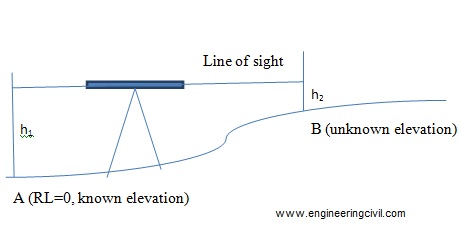Keywords: Levelling, principle, differential levelling, station, backsight, foresight, intermediate sight, change point, turning point, balancing
Let’s now move on to the basic principle of levelling. If you want to refresh the basic concepts of levelling, you can read them here.
Simple levelling
When the levelling instrument is properly leveled, the bubble tube axis and the line of sight will be horizontal and the vertical axis of the instrument will be vertical. The bubble must be central and traverse. The line of sight will remain in a horizontal plane when the telescope is rotated. Thus if the telescope is sighted towards a staff kept on a point of known elevation, the height or elevation of the line of sight can be determined. If the telescope is now directed to staff kept on points of unknown elevation, the staff readings can be read. From which the reduced levels of the unknown points can be determined.

Reduced level of the line of sight, RL= 0 + h1 =h1
Reduced level of the point B = h1-h2
With a levelling instrument, it is possible to establish only a horizontal line not a level line. However,for the smalldistances involved in ordinary levelling, the distinction between level line and horizontal line is negligible. The errors due to instrumental faults can be eliminated if the points are equidistant from the levelling instrument. If the point is lower, then the staff reading will be higher.
Terms used in levelling
Some of the commonly used terms in levelling are defined as follows:
Station
Station is a point whose elevation is to be determined or it is thepoint which is to be marked at a given elevation. It is the point where the staff is held for taking observations from a levelling instrument.
Height of the instrument (HI)
It is the elevation or reduced level of the line of sight with respect to the datum. Height of the instrument is not the height of the line of sight above the ground where the levelling instrument is set up.
Height of the instrument= elevation of BM+ backsight
Balancing of sight
To reduce the effect of instrumental and other errors, this method is adopted.The distance of the point where the backsight is taken and the distance of the point where a foresight is taken, as measured from the instrument station, has to be approximately same. This is known as balancing of sights. The intermediate sights do not comply with the condition of equal length of sights.
Differential levelling
Differential levelling is also called as compound levelling or continuous levelling. It is adopted when the points whose elevation is to be determined are too far apart or the difference in elevation is too large. In this levelling, the instrument has to be setup at several positions and at each set up the principle of simple levelling is used.
Change point or TP

Some of the terms connected to differential levelling are explained as follows:
Backsight (BS) or Backsight reading
It is a staff reading taken on a point of known elevation, as on a benchmark or a change point. This is also called as a plus sight. The backsight is the first staff reading taken after the level is set up and leveled at the point.
Foresight (FS) or Foresight reading
It is a staff reading taken on a point whose elevation has to be determined through levelling process. It is also known as minus sight. The foresight is also taken towards a change point. It is the last reading taken before the instrument is shifted.
Elevation of station= height of instrument (HI) – foresight (FS) or intermediate sight (IS)
Intermediate sight (IS)
It is the staff readings taken on staff held at other points whose elevations are to be determined before the foresight is taken. Intermediate sights are all staff readings between the B.S and F.S
Change point or Turning point (TP)
It is a point denoting the shifting of the level. It is a station at which both BS and FS readings are taken. Stable and well defined objects must be chosen as change points for accurate results.
If you have a query, you can ask a question here.


